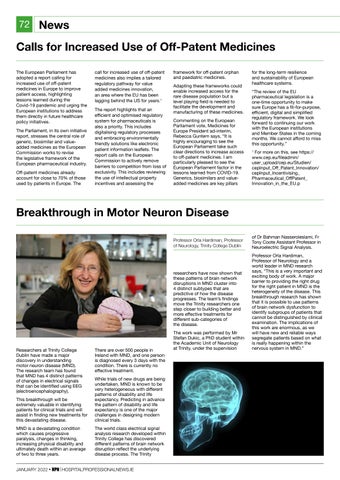72 News
Calls for Increased Use of Off-Patent Medicines The European Parliament has adopted a report calling for increased use of off-patent medicines in Europe to improve patient access, highlighting lessons learned during the Covid-19 pandemic and urging the European institutions to address them directly in future healthcare policy initiatives. The Parliament, in its own initiative report, stresses the central role of generic, biosimilar and valueadded medicines as the European Commission works to revise the legislative framework of the European pharmaceutical industry. Off-patent medicines already account for close to 70% of those used by patients in Europe. The
call for increased use of off-patent medicines also implies a tailored regulatory pathway for value added medicines innovation, an area where the EU has been lagging behind the US for years.1 The report highlights that an efficient and optimised regulatory system for pharmaceuticals is also a priority. This includes digitalising regulatory processes and embracing environmentally friendly solutions like electronic patient information leaflets. The report calls on the European Commission to actively remove barriers to competition from loss of exclusivity. This includes reviewing the use of intellectual property incentives and assessing the
framework for off-patent orphan and paediatric medicines. Adapting these frameworks could enable increased access for the rare disease population but a level playing field is needed to facilitate the development and manufacturing of these medicines. Commenting on the European Parliament vote, Medicines for Europe President ad-interim, Rebecca Guntern says, “It is highly encouraging to see the European Parliament take such clear directions to increase access to off-patent medicines. I am particularly pleased to see the European Parliament factor in the lessons learned from COVID-19. Generics, biosimilars and valueadded medicines are key pillars
for the long-term resilience and sustainability of European healthcare systems. “The review of the EU pharmaceutical legislation is a one-time opportunity to make sure Europe has a fit-for-purpose, efficient, digital and simplified regulatory framework. We look forward to continuing our work with the European institutions and Member States in the coming months. We cannot afford to miss this opportunity.” For more on this, see https:// www.cep.eu/fileadmin/ user_upload/cep.eu/Studien/ cepInput_Off_Patent_Innovation/ cepInput_Incentivising_ Pharmaceutical_OffPatent_ Innovation_in_the_EU.p
1
Breakthrough in Motor Neuron Disease Professor Orla Hardiman, Professor of Neurology, Trinity College Dublin
researchers have now shown that these patterns of brain network disruptions in MND cluster into 4 distinct subtypes that are predictive of how the disease progresses. The team’s findings move the Trinity researchers one step closer to building better and more effective treatments for different sub-categories of the disease.
Researchers at Trinity College Dublin have made a major discovery in understanding motor neuron disease (MND). The research team has found that MND has 4 distinct patterns of changes in electrical signals that can be identified using EEG (electroencephalography).
There are over 500 people in Ireland with MND, and one person is diagnosed every 3 days with the condition. There is currently no effective treatment.
This breakthrough will be extremely valuable in identifying patients for clinical trials and will assist in finding new treatments for this devastating disease.
While trials of new drugs are being undertaken, MND is known to be very heterogeneous with different patterns of disability and life expectancy. Predicting in advance the pattern of disability and life expectancy is one of the major challenges in designing modern clinical trials.
MND is a devastating condition which causes progressive paralysis, changes in thinking, increasing physical disability and ultimately death within an average of two to three years.
The world class electrical signal analysis research developed within Trinity College has discovered different patterns of brain network disruption reflect the underlying disease process. The Trinity
JANUARY 2022 • HPN | HOSPITALPROFESSIONALNEWS.IE
The work was performed by Mr Stefan Dukic, a PhD student within the Academic Unit of Neurology at Trinity, under the supervision
of Dr Bahman Nasseroleslami, Fr Tony Coote Assistant Professor in Neuroelectric Signal Analysis. Professor Orla Hardiman, Professor of Neurology and a world leader in MND research says, “This is a very important and exciting body of work. A major barrier to providing the right drug for the right patient in MND is the heterogeneity of the disease. This breakthrough research has shown that it is possible to use patterns of brain network dysfunction to identify subgroups of patients that cannot be distinguished by clinical examination. The implications of this work are enormous, as we will have new and reliable ways segregate patients based on what is really happening within the nervous system in MND.”







